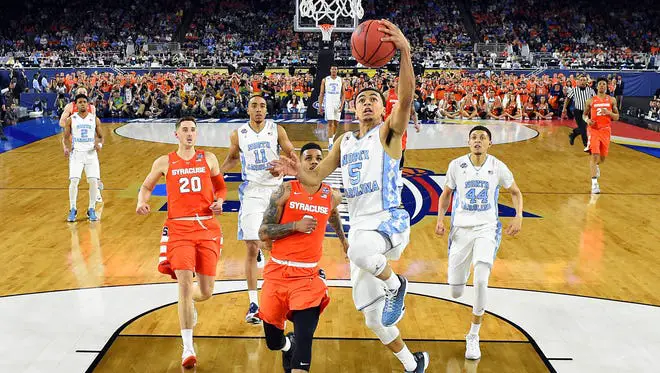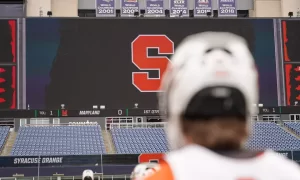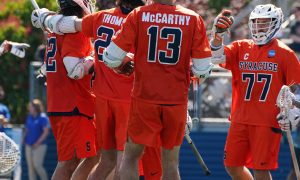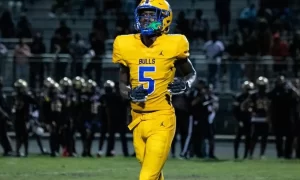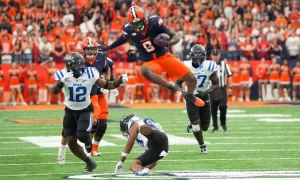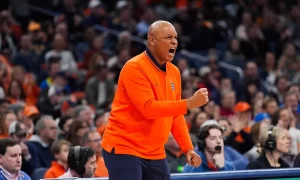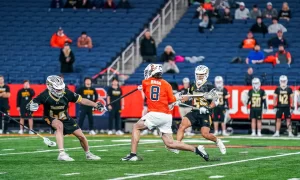First Round 2019 | 9-seed Baylor, 78 vs 8-seed Syracuse, 69
This game was an absolute shooting frenzy. The Bears won 78-69 behind 47% shooting clip from beyond the arc. Makai Mason stroked a quintuple of three-pointers on his way to a team-best 22 points. Baylor won this game by shooting over 50% in both halves, and hitting 16/34 treys.
This was a historic performance the Bears put on display, and they still almost lost. Baylor‚Äôs 16 made three-pointers set a new Syracuse NCAA Tournament record for most made trifecta‚Äôs by an opponent. If San Diego State wants to beat the zone, they’ll need similar success from the perimeter.
Sweet Sixteen 2018 | 2-seed Duke, 69 vs 11-seed Syracuse, 65
The last thing you want if your Coach Boeheim and Company is to play a fellow ACC team during March. It’s not the end of the world, but a team like Duke is much more prepared to face the zone and already saw it during the regular season. The Blue Devils routed the Orange 60-44 in the regular season game.
In both matchups Duke was atrocious from beyond the arc. Between the two contests the Dukies combined to make just seven three-pointers. So how did they beat the SU zone? Free throws. The Blue Devils scored upwards of 30 points in the paint in both contests and got to the charity stripe for 28 attempts in the Sweet Sixteen.
The Blue Devils clearly weren’t a world beater from downtown, but they found other ways to win. Coach K simply pounded the rock inside with his three different 5 star forwards. Paschal Chukwu was in foul trouble with 4 and Duke secured 16 offensive rebounds. Wendell Carter Jr. was 8-11 from the free throw line, and Marvin Bagley was 6-8 while also corralling 6 offensive rebounds.
Practically the same strategy Duke used in the regular season meeting. The Blue Devils were 14-16 from the line and won the rebounding advantage. Also when you hold a team to 44 points these days, you should win. Here’s the takeaway, the Orange will be competitive if its opponent struggles to connect from outside. San Diego State won’t dominate Syracuse in the paint because SU has played North Carolina twice, the best offensive rebounding team in the country and ‘Cuse still found a way to beat them.
Final Four 2016 | 1-seed North Carolina, 83 vs 10-seed Syracuse, 66
Another case of SU running into a conference-foe deep in the tourney. Let’s be real this team exceeded expectations, but for the sake of the case study let’s continue. Much like Duke in 2018, the Heels beat SU in the regular season (twice). The blueprint for beating the zone was previously designed.
UNC led 39-28 at the half behind a 26-12 advantage in the paint. The zone held the Tar Heels to 0-10 from beyond the arc, but Carolina had success inside. At the end of the contest UNC had a 43-31 rebounding advantage and 50-32 points in the key. I feel like I’ve heard this story before?
Once again, North Carolina did not shoot the ball well from anywhere outside the paint. The Tar Heels were just 4-17 from deep, and unlike Duke, only got to the line for 11 shots. The Tar Heels were very efficient inside. SU and UNC tied for 16 offensive boards a piece, but here’s your padlock stat. North Carolina shot 48% from the field in the first half, 60% in the second half to along with 4-7 shooting in the second frame from deep.
The takeaway here is that UNC was VERY efficient in the paint and rarely missed around the rim. That was consistent in both halves and the Heels sprinkled in 57% shooting from downtown in the second half. There’s no glaring differential in rebounding or free throws, UNC simply made everything within 10-feet of the iron.
Second Round 2014 | 11-seed Dayton, 55 vs 3-seed Syracuse, 53
The Flyers gave Syracuse a taste of its own medicine in upset fashion. This research paper is about defense, but the Orange lost this game because it failed to make a single three-pointer. That was the first time that happened to a Syracuse team since March 10, 1995. A stretch of 664 consecutive games. When something historic happens it usually means you win, but not on this day
As for the defense, it was solid. Syracuse held Dayton to just 55 points. More often than not, when you hold an opponent to 55 you’ll win, but again not on this day. The Flyers led 20-18 at the half, despite shooting 1-5 from beyond the arc. Dayton turned it up in the second half, making 6-11 attempts from deep. The Flyers also had 18 shots at the free throw line, but made just 10 of those. SU was 11-14 so that’s not a valid answer.
It’s pretty simple, Dayton shot upwards of 50% from three in the second half and still nearly lost to Syracuse. The zone did its job in this contest, seven trey balls won’t do much in the effort to beat the SU defense. It was the offense that failed on this day, you cannot go without a three-pointer and still win a game, yet SU nearly did because of the zone.
Final Four 2013 | 4-seed Michigan, 61 vs 4-seed Syracuse, 56
This was a tremendous game. Growing up a Michigan fan I was pleased with this outcome, but it easily could’ve gone either way, let’s discuss. Michael “Spike” Albrecht was the difference. Albrecht averaged 1.8 points per game entering the contest, but this is March. Athletes make their names in this month and that’s exactly what Albrecht did.
The backup point guard played just four minutes, but hit a pair of threes to give Michigan a 36-25 lead at the half. Syracuse came back, but could never fully topple that 11 point halftime deficit. Michigan also got a good lift off the bench from former Brooklyn Net Caris Levert. He entered the contest averaging just 2.4 points per game but hit a pair of shots from deep to go en route to an 8 point, 2 assist outing.
On a macro scale, the Wolverines beat the zone doing a little bit of what every team above did to win. U of M didn;t dominate in one category, but did everything to a winning level. Coach John Beilien’s team shot 8-24 from beyond the arc, had 20 free throw attempts, and won the rebounding battle 37-33, with 13 offensive boards. Syracuse simply caught Michigan at the wrong time, this team could do no wrong.
2013 Naismith Player of the Year Trey Burke scored just seven points, former Knick Tim Hardaway Jr. was just 3-10 from downtown, and Nik Stauskas (UM’s shooter) was 0-5 from the floor. What won the Wolverines the game was 21 points off the bench in conjunction with the numbers previously mentioned. Michigan had the recipe to beat the zone: shoot well (enough) from the perimeter, get to the free throw line (11-20), and get after it in the paint (13 offensive rebounds).
Elite Eight 2012 | 2-seed Ohio State, 77 vs 1-seed Syracuse, 70
Well buckle up because this is crazy. SU and OSU combined for 67 free throw attempts. The Buckeyes had 42 of those and went 31-42. That’s unbelievable. Probably near impossible to beat a team that scores over half their points from the charity stripe. Five different SU players had four fouls, James Southerland and Dion Waiters fouled out. Syracuse was whistled for 29 fouls as a team, and Coach Boeheim picked up a technical. That right there is a good indicator of how Ohio State won, but let’s try and find another contributor.
The Buckeyes also won the rebounding battle 39-26 with 14 on the offensive glass. Reminder: SU was playing without Fab Melo due to an academic violation. His absence was definitely felt.
OSU was just 4-13 from beyond the arc so that wasn’t the achilles heel. Ohio State dominated in the paint in the absence of Melo and took advantage of ticky-tack officiating with 31 points from the charity stripe.
There isn’t one set foundation that’s been laid for San Diego State to beat the SU zone. If the Aztecs shoot well from three, win the rebounding battle, and get to the free throw line they’ll have a great chance. Michigan is the only team to do all three of those things well, and SU still nearly won, despite the 21 bench points the Wolverines benefited from.
SDSU is 20th in the kenpom rankings and is projected to beat SU 71-68. The Aztecs are 44th in offensive efficiency scoring 111.5 points per 100 possessions. As far as four offensive factors, SDSU is 62nd in field goal percentage (52.7% per 100 possessions), 74th in turnover percentage (16.9% per 100 possessions), 109th in offensive rebounding percentage (29.9% per 100 possessions), and 99th in free throws attempted/field goals attempted (34.3% per 100 possessions). SDSU is also 28th in the country shooting 37.5% from three.
So in summation, the Aztecs are a good three-point shooting team, they don’t turn the ball over very much, and are above average on the offensive glass. It’s important to keep in mind the level of competition they’re putting up these numbers against and the type of defenses they’ve played. However, SDSU has the tools to beat the zone by shooting well from deep, rebounding, and getting to the stripe.


